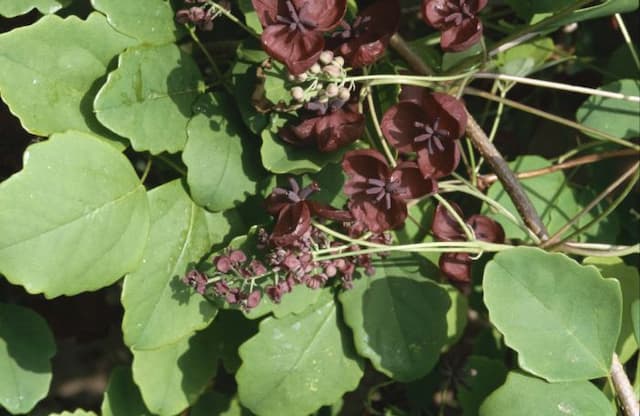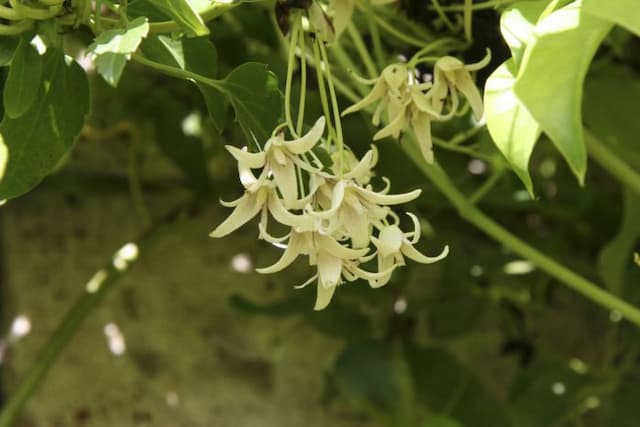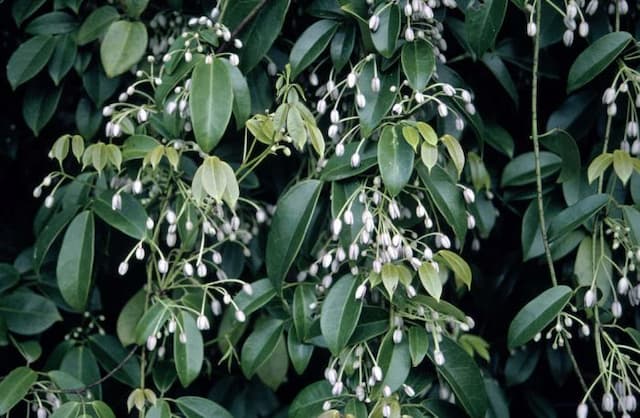Sausage Vine Holboellia latifolia

ABOUT
The plant commonly known as Sausage Vine is a striking evergreen climber with broad, glossy, leathery leaves which typically have three leaflets. Its vigorous twining stems bear these leaves in a lush, dense fashion, creating a rich tapestry of green throughout the year. In springtime, the Sausage Vine produces clusters of fragrant flowers that are quite distinctive. The male and female flowers appear on separate plants. Male flowers are usually more showy with prominent purplish-pink petals, whereas female flowers are more subdued, often greenish-white in color. If pollinated, the female flowers develop into intriguing sausage-shaped purple fruits that can add an exotic touch to the plant's appearance. The play of colors on this vine—from the deep green foliage, the purplish-pink or greenish-white blooms, to the striking purple fruits—makes it a captivating sight in any garden.
About this plant
 Names
NamesFamily
Lardizabalaceae.
Synonyms
Sausage Vine, Chinese Sausage Vine, Himalayan Sausage Vine, Akebia Quinata.
Common names
Akebia longeracemosa, Stauntonia henryi, Stauntonia obovatifoliola, Stauntonia obovata.
 Toxicity
ToxicityTo humans
Sausage vine is not commonly known to be toxic to humans. There are no well-documented cases of poisoning or serious side effects from ingesting parts of the sausage vine, which suggests that this plant is generally considered safe. However, it is always prudent not to eat parts of ornamental plants due to the potential for unidentified toxic compounds or individual allergic reactions.
To pets
Sausage vine is not widely recognized as a toxic plant to pets. There generally aren't reports of serious illness or symptoms associated with pets ingesting this plant. As with any non-food plant, pets may experience mild gastrointestinal upset if they consume parts of the sausage vine, but significant toxicity is not commonly reported. To be safe, it is always recommended to prevent pets from eating ornamental plants.
 Characteristics
CharacteristicsLife cycle
Perennials
Foliage type
Evergreen
Color of leaves
Green
Flower color
Purple
Height
20 feet (6 meters)
Spread
20 feet (6 meters)
Plant type
Climber
Hardiness zones
8
Native area
China
Benefits
 General Benefits
General Benefits- Ornamental value: The Cathedral Gem, as Holboellia latifolia is commonly referred to, is a fast-growing evergreen vine with attractive foliage and fragrant flowers which add aesthetic appeal to gardens.
- Privacy screening: Due to its dense growth habit, it can be trained on trellises or fences to create a natural privacy screen for patios and garden areas.
- Wildlife attraction: The plant produces sweet-scented flowers that are highly attractive to pollinators such as bees, and its fruit can offer food for birds and other wildlife.
- Shade provision: With its rapid growth and thick foliage, the Cathedral Gem can create shaded areas in gardens, which can help in reducing local temperature and providing cool spots during hot days.
- Aromatic qualities: The fragrant flowers of the Cathedral Gem can provide a pleasant scent to the garden, enhancing the sensory experience of the environment.
- Architectural interest: Its vigorous climbing habit and evergreen leaves make it useful for adding greenery to architectural features like pergolas, arches, and walls.
- Year-round interest: Being an evergreen plant, Holboellia latifolia retains its leaves throughout the seasons, ensuring that gardens have a consistent green backdrop.
 Medical Properties
Medical PropertiesThis plant is not used for medical purposes.
 Air-purifying Qualities
Air-purifying QualitiesThis plant is not specifically known for air purifying qualities.
 Other Uses
Other Uses- Architectural Plant: Sausage Vine can be used to create natural green architecture, providing a lush backdrop or green cover for pergolas and archways.
- Wildlife Attractant: This plant can be used to attract pollinators such as bees and butterflies, making it ideal for wildlife gardens.
- Screening Plant: Due to its vigorous growth habit, Sausage Vine can be used to create living screens for privacy or to hide unsightly areas in the garden.
- Container Gardening: It can be grown in large containers where ground space is limited, providing greenery on patios or balconies.
- Shade Gardening: Sausage Vine is suitable for shady areas under trees where other plants may struggle to grow, enhancing dark garden spots with its foliage.
- Fragrance Garden: The plant's fragrant flowers can contribute to a sensory garden experience.
- Vertical Accents: Its climbing nature allows it to be used for adding vertical elements to the garden, creating height without the need for large trees or structures.
- Culinary Use: The fruits of Sausage Vine, although not commonly eaten, can be used in certain culinary traditions when ripe.
- Topiary Support: It can be trained over frames to form topiary shapes, providing an evergreen structure in the garden.
- Seasonal Interest: Its evergreen leaves, fragrant spring flowers, and elongated fruits can provide multiple seasons of visual interest in the garden.
Interesting Facts
 Feng Shui
Feng ShuiThe Chinese Sausage Vine is not used in Feng Shui practice.
 Zodiac Sign Compitability
Zodiac Sign CompitabilityThe Chinese Sausage Vine is not used in astrology practice.
 Plant Symbolism
Plant Symbolism- Exotic Flair: As the Cathedral Gem is not as commonly known as other plants, it symbolizes the allure and mystery of the exotic. It often represents a unique beauty or a fascination with foreign cultures and unexplored territories.
- Vitality: The vigorous growth habit of the Cathedral Gem embodies robust health and vitality, symbolizing an abundance of life and energy.
- Harmony with Nature: Being a vigorous climber that easily adapts to its surroundings, the Cathedral Gem can represent harmonious coexistence with the natural world and a balance between human structures and nature.
- Protection or Shelter: Due to its nature as a dense vine that provides cover, the Cathedral Gem may symbolize protection or a haven, offering a sheltering presence in gardens.
 Water
WaterThe Chinese Bluebeard or Holboellia latifolia should ideally be watered deeply once or twice a week, depending on the climate and the soil moisture level. A good rule of thumb is to offer about 1 to 1.5 gallons of water for young plants and up to 2.5 gallons for established plants per watering session. During hot, dry spells, watering frequency may increase, while in cooler, wetter conditions, it can be reduced. Ensure the top inch of soil is dry before watering again to prevent overwatering, which can harm the plant. Avoid letting the plant sit in waterlogged soil as this can lead to root rot.
 Light
LightChinese Bluebeard thrives best in partial shade to full sun conditions. It can tolerate a range of light conditions, but for optimal growth and flowering, a spot that receives morning sunlight and afternoon shade is ideal. Avoid deep shade, as this can reduce flowering and lead to leggy growth.
 Temperature
TemperatureChinese Bluebeard can survive temperatures as low as 5 degrees Fahrenheit but performs best in an environment where temperatures range between 60 to 75 degrees Fahrenheit. Extreme heat above 90 degrees Fahrenheit may stress the plant, so during very hot periods, providing some shade and extra water can be beneficial. Always ensure that the plant is protected from severe frost and harsh winter winds.
 Pruning
PruningPrune Chinese Bluebeard to maintain shape and encourage bushier growth. Pruning is best done in late winter or early spring before new growth starts. Deadheading spent flowers can promote a second bloom. Pruning every year or every other year is sufficient, and it helps to remove any dead or damaged branches to maintain plant health.
 Cleaning
CleaningAs needed
 Soil
SoilCathedral Bells (Holboellia latifolia) thrives in well-draining soil with a lot of organic matter. A fertile loam-based mix with added compost and perlite or sand is ideal. The best soil pH for Cathedral Bells is slightly acidic to neutral, ranging from about 6.0 to 7.0.
 Repotting
RepottingCathedral Bells should be repotted every 2 to 3 years or when root-bound. This vigorous climber may require more frequent repotting if grown in smaller containers or when it is younger and growing more rapidly.
 Humidity & Misting
Humidity & MistingCathedral Bells prefers a moderate to high humidity level, ideally around 50-70%. Ensuring good air circulation while maintaining humidity supports healthy growth without promoting disease.
 Suitable locations
Suitable locationsIndoor
Provide bright, indirect light and a sturdy trellis.
Outdoor
Plant in semi-shade, sheltered spot, and support with trellis.
Hardiness zone
7-9 USDA
 Life cycle
Life cycleHolboellia latifolia, commonly known as the Chinese Sausage Vine, begins its life cycle as a seed, which, under suitable conditions of warmth and moisture, will germinate and develop a root system and shoot. The shoot grows into a vigorous, evergreen climbing vine, which, if provided with support, can rapidly cover structures and climb trees. During the spring, the mature plant produces fragrant, purple or pink flowers, which are dioecious, meaning male and female flowers occur on separate plants. After pollination, typically by insects, female flowers develop into oblong, sausage-shaped fruits which can be several inches long. These fruits mature, typically turning a pink or purple color, and eventually disperse seeds either through animal consumption and subsequent dispersal or by falling to the ground. The plant can also propagate vegetatively through cuttings, allowing the cycle to continue without seed production.
 Propogation
PropogationPropogation time
Spring-summer
The most popular method of propagating the Cathedral Gem (Holboellia latifolia) is through semi-ripe cuttings. This process is usually done in the late summer when the new growth has begun to harden. Cuttings should be about 4 to 6 inches (10 to 15 cm) long and include a small portion of the previous year’s wood. It’s important to make a clean cut below a leaf node and remove the lower leaves to expose the nodes where roots will form. The cut end can be dipped in rooting hormone to stimulate root growth before being placed in a well-draining potting mix. The cuttings should be kept under high humidity and indirect light until they root, which typically takes several weeks. Once rooted, the young plants can be potted on and eventually planted out in the garden.




